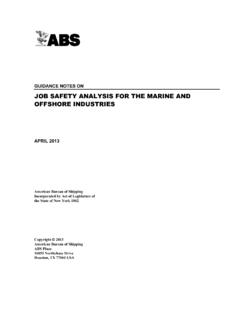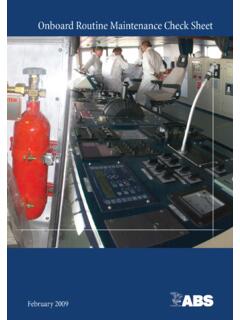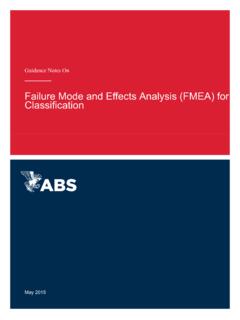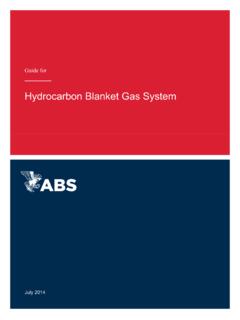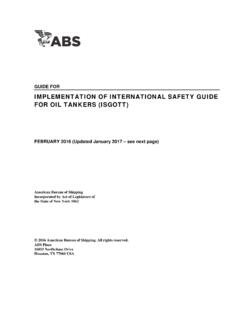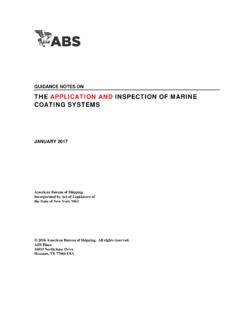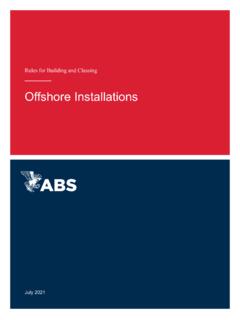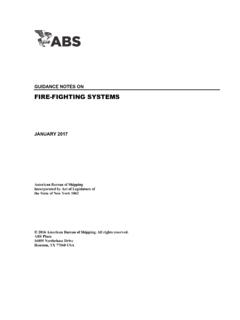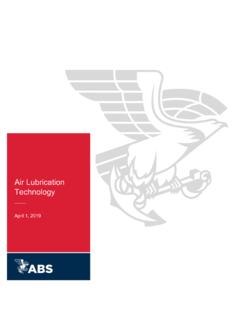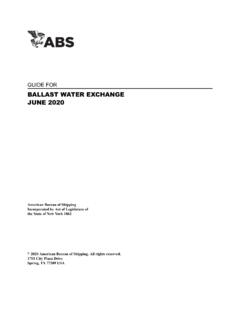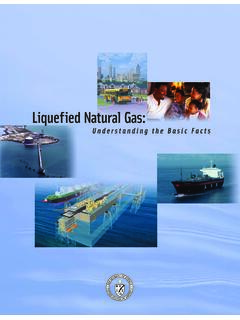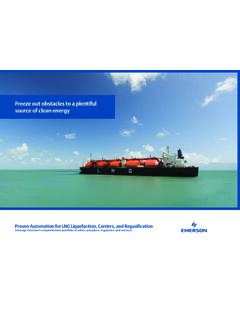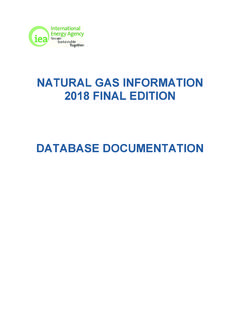Transcription of LNG BUNKERING TECHNICAL AND OPERATIONAL ADVISORY
1 ABS | LNG BUNKERING TECHNICAL AND OPERATIONAL ADVISORY | 01 VladSV/Shutterstock LNG BUNKERING TECHNICAL AND OPERATIONAL ADVISORY OUR MISSION The mission of ABS is to serve the public interest as well as the needs of our members and clients by promoting the security of life and property and preserving the natural environment. HEALTH, SAFETY, QUALITY & ENVIRONMENTAL POLICY We will respond to the needs of our members and clients and the public by delivering quality service in support of our Mission that provides for the safety of life and property and the preservation of the marine environment.
2 We are committed to continually improving the effectiveness of our HSQE performance and management system with the goal of preventing injury, ill health and pollution. We will comply with all applicable legal requirements as well as any additional requirements ABS subscribes to which relate to HSQE aspects, objectives and targets. Disclaimer: While ABS uses reasonable efforts to accurately describe and update the information in this ADVISORY , ABS makes no warranties or representations as to its accuracy, currency or completeness. ABS assumes no liability or responsibility for any errors or omissions in the content of this ADVISORY .
3 To the extent permitted by applicable law, everything in this ADVISORY is provided as is without warranty of any kind, either expressed or implied, including, but not limited to, the implied warranties of merchantability, fitness for a particular purpose, or noninfringement. In no event will ABS be liable for any damages whatsoever, including special, indirect, consequential or incidental damages or damages for loss of profits, revenue or use, whether brought in contract or tort, arising out of or connected with this ADVISORY or the use or reliance upon any of the content or any information contained herein.
4 TABLE OF CONTENTS 1 INTRODUCTION .. 1 2 GENERAL INFORMATION ON LNG .. 2 3 GENERAL CONSIDERATIONS FOR LNG BUNKERING .. 3 4 KEY CHARACTERISTICS AFFECTING TANK CAPACITY FOR BUNKERING LNG .. 4 5 VESSEL COMPATIBILITY .. 7 6 OPERATIONAL ISSUES ABOARD THE RECEIVING SHIP .. 8 DURING THE BUNKERING PROCESS .. 8 OTHER OPERATIONAL PHASES RELATED TO LNG STORAGE .. 12 SIMULTANEOUS CARGO OPERATIONS .. 14 7 SPECIAL EQUIPMENT REQUIREMENTS ABOARD THE RECEIVING 16 BUNKER STATIONS .. 16 BUNKER PIPING SYSTEMS .. 17 8 LNG STORAGE TANKS AND SYSTEMS FOR MONITORING AND CONTROL OF STORED LNG.
5 19 9 OPERATIONAL AND EQUIPMENT ISSUES FROM THE SUPPLIER SIDE .. 22 BUNKERING FROM ONSHORE FACILITY .. 22 BUNKER VESSELS .. 23 SUPPLIER S TANK TYPES .. 24 SUPPLIER S TANK PRESSURE AND TEMPERATURE .. 24 EQUIPMENT AND OPERATIONAL 25 10 BUNKER OPERATIONS .. 27 SEQUENCE .. 27 EMERGENCY PROCEDURES .. 28 RESPONSIBILITIES .. 28 MANNING .. 28 PROCEDURES AND MANUALS .. 29 CHECKLISTS .. 29 CREW TRAINING AND CERTIFICATION .. 31 11. COMMERCIAL ISSUES AND CUSTODY TRANSFER .. 32 PRICING BASIS .. 32 CUSTODY TRANSFER .. 32 FUEL SPECIFICATIONS AND 33 REGULATORY FRAMEWORK.
6 35 REGULATORY ORGANIZATIONS AND REQUIRED APPROVALS .. 35 OVERVIEW OF 36 13 SAFETY AND RISK ASSESSMENTS ..42 Major Hazards ..42 Safety and Security Zones ..45 Risk Assessment Methodology and Reporting ..46 Simultaneous Operations (SIMOPS) Study ..49 14 LIST OF GUIDANCE DOCUMENTS AND SUGGESTED REFERENCES .. 50 15 APPENDIX - LNG CHARACTERISTICS ..52 Typical LNG Heating Values, Methane Number and Wobbe Typical LNG Density ..52 100 Percent Methane Saturated Properties ..53 TABLES Table 1: LNG BUNKERING Initiating Events and Table 2. Likelihood Table 3.
7 Representative Consequence Categories ..48 Table 4. Risk Levels ..49 FIGURES Figure 1. Typical Atmospheric Tank Loading Limit ..5 Figure 2. Typical Pressurized Tank Loading Limit ..5 Figure 3. Inerting and Purging Sequence of LNG Bunker Hose and Piping ..10 Figure 4. Typical Isolating Flange .. 12 Figure 5. Rollover After Figure 6. Typical Arrangement of Bunker Piping and Connections ..20 Figure 7. Typical Methods of BUNKERING a Gas Fueled Ship .. 22 Figure 8. Marine Terminals for Loading LNG Bunker Barges, Trucks, ISO Containers and Third-party Vehicles.
8 23 Figure 9. Example of Safety and Security Zones ..45 ABS | LNG BUNKERING TECHNICAL AND OPERATIONAL ADVISORY | 1 1 INTRODUCTION Owners, operators, designers and shipyards around the world are considering the advantages that operating on natural gas may provide. However, when considering any new or evolving technology, it is important to have a clear understanding of not only the benefits, but the challenges that may be involved. This ADVISORY has been developed in order to respond to the need for better understanding by members of the maritime industry of the issues involved with BUNKERING vessels with natural gas.
9 It is intended to provide guidance on the TECHNICAL and OPERATIONAL challenges of LNG BUNKERING operations both from the bunker vessel s perspective (or land-side source) and from the receiving vessel s perspective. Some of the key areas that are addressed in this ADVISORY are critical design issues, methods of analysis, and current thinking on possible solutions to the requirements of regulations and safe practice, as well as important areas of OPERATIONAL process, training and safeguards. The regulatory framework is referenced, but this ADVISORY is not rule or region-specific.
10 For further information and insight into the regulatory framework associated with LNG BUNKERING in North America, refer to the ABS report, BUNKERING of liquefied natural Gas-fueled Marine Vessels in North America. This ADVISORY does, however, provide guidance on the ramifications of the various requirements on vessel design and OPERATIONAL issues, and how they impact the LNG BUNKERING process. This information can be useful to any owner, operator, designer or shipyard considering LNG fuel so that an informed decision can be made. The following sections are included in the ADVISORY .
